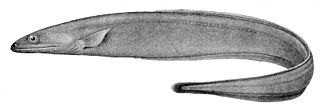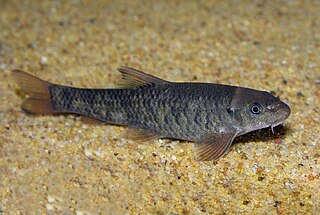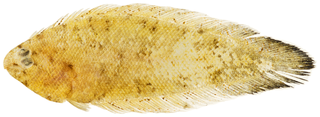
Grenadiers or rattails are generally large, brown to black gadiform marine fish of the subfamily Macrourinae, the largest subfamily of the family Macrouridae. Found at great depths from the Arctic to Antarctic, members of this subfamily are amongst the most abundant of the deep-sea fish.

Puntius is a genus of small freshwater fish in the family Cyprinidae native to South Asia and Mainland Southeast Asia, as well as Taiwan.

The superorder Elopomorpha contains a variety of types of fishes that range from typical silvery-colored species, such as the tarpons and ladyfishes of the Elopiformes and the bonefishes of the Albuliformes, to the long and slender, smooth-bodied eels of the Anguilliformes. The one characteristic uniting this group of fishes is they all have leptocephalus larvae, which are unique to the Elopomorpha. No other fishes have this type of larvae.

Fundulus is a genus of ray-finned fishes in the superfamily Funduloidea, family Fundulidae. It belongs to the order of toothcarps (Cyprinodontiformes), and therein the large suborder Cyprinodontoidei. Most of its closest living relatives are egg-laying, with the notable exception of the splitfin livebearers (Goodeidae).

Mustelus, also known as the smooth-hounds, is a genus of sharks in the family Triakidae. The name of the genus comes from the Latin word mustela, meaning weasel. It should not be confused with the genus name Mustela, which is used for weasels.
Neocyema erythrosoma is a species of pelagic fish, a deep-water bobtail snipe eel in the family Cyematidae. It is the only member of its genus, Neocyema. It was first described by Peter Castle in 1978 after two specimens were caught at great depths in the south Atlantic Ocean in 1971. Further specimens have since been caught in the North Atlantic.

Synaphobranchus is a genus of eels in the cutthroat eel family, Synaphobranchidae. It currently contains the following species:

Leptocephalus is a genus that was used for species of larval eels, called leptocephali. Leptocephali larvae differ so much in appearance from their adults. When first discovered, leptocephali were thought to be a distinct type of fish, not an eel specie. Because of this, the genus designation of Leptocephalus was used for a while for an unidentified leptocephali. After it was known that these were eel larvae, it was identified to be part of a wastebasket taxon, but not anymore in the present classification system. Examples of marine congrid larvae, found in the western Indian Ocean and the Red Sea that were named this way are listed below. Only two species in two families are currently treated as having any validity, though the validity of L. bellottii is strongly in doubt.
Pterothrissus gissu, also known as the Japanese gissu, is a species of ray-finned fish in the family Albulidae. The Japanese gissu is a rare fish that is distributed in deep water off northwest Pacific Ocean. This fish is known to pass through a leptocephalus larval stage, but only metamorphosed specimens have been available. This species is the only member of its genus.

Garra is a genus of fish in the family Cyprinidae. These fish are one example of the "log suckers", sucker-mouthed barbs and other cyprinids commonly kept in aquaria to keep down algae. The doctor fish of Anatolia and the Middle East belongs in this genus. The majority of the more than 160 species of garras are native to Asia, but about one-fifth of the species are from Africa.

Sillago is a genus of fish in the family Sillaginidae and the only non-monotypic genus in the family. Distinguishing the species can be difficult, with many similar in appearance and colour, forcing the use of swim bladder morphology as a definitive feature. All species are benthic in nature and generally coastal fish, living in shallow, protected waters although there are exceptions. Minor fisheries exist around various species of Sillago, making them of minor importance in most of their range. This genus has the widest distribution of any smelt-whiting genus, spanning much of the Indo-Pacific. The genus ranges from the east coast of Africa to Japan in the east and Southern Australia in the south, with most species concentrated around South East Asia, the Indonesian Archipelago and Australia. Many species have overlapping distribution, often making positive identification hard.

Symphurus is a genus of fish in the family Cynoglossidae found in the Atlantic, Indian and Pacific Ocean. Most species mainly occur in relatively shallow water, including estuaries. Some species are also found in deeper water, including S. thermophilus that lives at hydrothermal vents. These species are distinguished by merged dorsal, caudal and anal fins, the absence of a lateral line and pectoral fins, and the presence of only one pelvic fin. They are sinistral flatfishes, meaning that as adults, their crania are asymmetrical, with both eyes on the left side. The largest species grows to about 32 cm (1 ft) long.

The Colocongridae, the worm eels or short-tail eels, are a family of eels, containing a single genus, Coloconger.

Heroini is a fish tribe from the Cichlasomatinae subfamily in the family Cichlidae (cichlids). All cichlids native to the Greater Antilles, United States, Mexico and northern Central America are members of this tribe. It also includes most cichlid species in southern Central America and several species from South America. A large percentage of its species were formerly placed in the genus Cichlasoma but have since been moved to other genera.

Cynoglossus is a genus of fish in the family Cynoglossidae. Most species are indigenous to the Indo-Pacific region, but there are also a few in warmer parts of the East Atlantic. They are commonly found in shallow waters on a muddy or sandy bottom, including estuaries and a few species are restricted to fresh water. One species Cynoglossus sinusarabici has invaded the Mediterranean Sea through the Suez Canal from the Red Sea, a process known as Lessepsian or Erythrean migration.

Pseudaspius, commonly called redfin daces, are a genus of cyprinid fishes found in marine and freshwater in eastern Asia, specifically the countries of Russia, Mongolia, China and Japan. Most species are diadromous into the Sea of Japan.
The giant leptocephalus is a species of eel in the family Notacanthidae. It was first described by Peter Henry John Castle in 1959. It is a marine, deep-water dwelling eel which is distributed worldwide.
Congriscus maldivensis is an eel in the family Congridae. It was described by John Roxborough Norman in 1939, originally under the genus Conger. It is a marine, deep water-dwelling eel which is known from the Indo-Western Pacific, including Australia, Fiji, Madagascar, Maldives, New Caledonia, the Philippines, Vanuatu, and Wallis and Futuna. It dwells at a depth range of 354–820 metres (1,161–2,690 ft). It can reach a maximum standard length of 35.2 centimetres (13.9 in).
Congriscus megastomus is an eel in the family Congridae. It was described by Albert Günther in 1877, originally under the genus Congromuraena. It is a marine, temperate-water dwelling eel which is known from Japan and the Kyushu–Palau Ridge, in the northwestern Pacific Ocean. It inhabits reefs. Males can reach a maximum total length of 40 centimeters. This species' remarkably large and distinct leptocephalus larvae were previously known under the name Thalassenchelys coheni. In 2016, scientists used genetic techniques to link the larvae to the adult C. megastomus. These larvae reach a maximum size of 30 cm (12 in) and have a number of unusual characteristics, including two forward-facing front teeth that may be used for feeding on different prey than other eel larvae.

Patagonotothen is a genus of marine ray-finned fishes, belonging to the family Nototheniidae, the notothens or cod icefishes. They are native to the southeast Pacific Ocean, southern Atlantic Ocean and the Southern Ocean.















